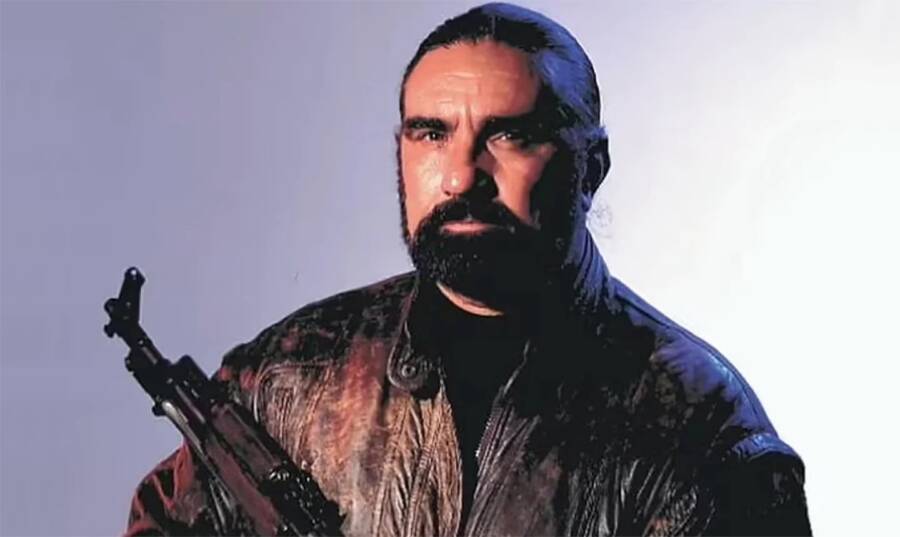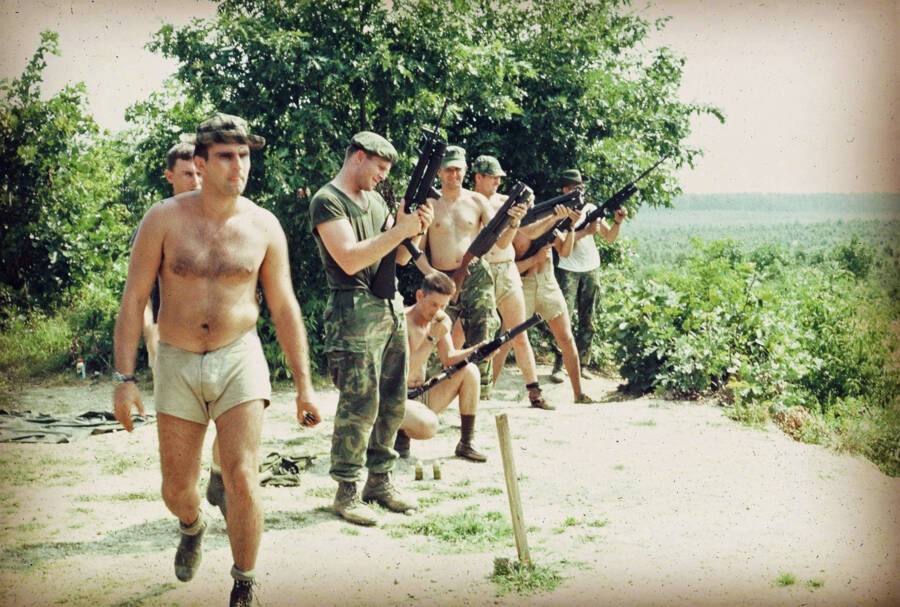Richard Marcinko led SEAL Team Six like a “mafioso,” and his personal flaws contributed to the special operation unit's DNA as much as his successes did.

TwitterRichard “Demo Dick” Marcinko propelled SEAL Team Six into the limelight through his books.
Richard Marcinko had a larger-than-life personality. Once upon a time, he was a U.S. Navy commander who served as the godfather of the elite special operations unit, SEAL Team Six. Later, he was an author whose name and face were plastered across the Rogue Warrior books. His voice was on the radio. He was a military consultant, an inspirational speaker, and an owner of FUBAR tequila.
But beneath his hardcore, tough-as-nails facade, “Demo Dick” Marcinko wasn’t quite the archetypal American hero he promoted himself as. In fact, according to those who served under him, Marcinko was best described as a “colorful character,” one whose past included many lies, heavy drinking, and a felony conviction.
This is everything you need to know about Richard Marcinko and his complicated legacy.
Richard Marcinko, The High School Dropout Who Was ‘Good At War’
Born in 1940 in Lansford, Pennsylvania, Richard Marciko was the son of George and Emilie Teresa Pavlik Marcinko, immigrants from Herzegovina and Slovakia — and every man in his family was a miner.
“They were born, they worked in the mines, they died. Life was simple and life was hard,” Marcinko later wrote in his book Rogue Warrior. “I guess some of them wanted to pull themselves up by their bootstraps, but most were too poor to buy boots.”
Marcinko went on to drop out of high school to begin his military career — only to be rejected from the U.S. Marines for not having a high school diploma. So instead, at age 18, Marcinko enrolled with the U.S. Navy, where he was sent off to fight in Vietnam in 1967 as a part of SEAL Team Two.

FacebookRichard “Demo Dick” Marcinko (left) at Camp Pickett.
According to The New York Times, Marcinko received numerous accolades for his service, including four Bronze Stars, a Silver Star, and a Vietnamese Cross of Gallantry. By his own account, Marcinko was such a ferocious fighter that the North Vietnamese even placed a bounty on his head.
“I’m good at war,” Marcinko once said. “Even in Vietnam, the system kept me from hunting and killing as many of the enemy as I would have liked.”
The Founding Of SEAL Team Six
In 1974, after two tours in Vietnam, Marcinko was given a promotion: He was now the commander of his former unit, SEAL Team Two. He commanded the unit for two years, but his true claim to fame came in 1980, when the United States attempted to rescue 53 Americans taken hostage in Iran. The operation, dubbed Eagle Claw, was unsuccessful.
Eight service members died, the hostages remained in captivity, and the operation was an enormous embarrassment for President Jimmy Carter.
In Marcinko’s words, it was “One humungous goat f–k. One big waste.”
Following the failure of Eagle Claw, the United States determined it was time to establish a new special operations unit to handle intense terrorist situations — and Marcinko was selected to lead it.
Marcinko dubbed this new team SEAL Team Six, but it wasn’t actually the sixth SEAL team. There were, in truth, only two other SEAL teams, but Marcinko felt that he could deceive his enemies and make them think the force was much larger by giving it this moniker. Thus, SEAL Team Six was born.
Richard Marcinko’s Maverick Reputation And The SEAL Team Six ‘Mafia’
SEAL Team Six, and Marcinko especially, quickly garnered a reputation for paying no mind to the rules. In Rogue Warrior, Marcinko noted that he felt it was important for his team to drink together — and get into drunken bar fights.

FacebookRichard Marcinko authored several books in the Rogue Warrior series, which inspired a video game of the same name.
Perhaps unsurprisingly, not everyone in the military shared Marcinko’s attitude when it came to rowdiness and discipline. Following Marcinko’s death, Rolling Stone investigative journalist Matthew Cole spoke with numerous sources who worked with Marcinko in his SEAL days.
According to Cole’s report, Marcinko’s “autobiographical” accounts may not have been as accurate as he claimed. Cole’s book Code Over Country: The Tragedy and Corruption of SEAL Team Six further examines the character of Richard Marcinko in contrast with the real man.
“As Marcinko recruited for his unit, another characteristic emerged,” Cole wrote. “Marcinko liked to drink, and any SEAL who wanted to serve in his new, secret, and elite team would have to be able to drink as well.”
Marcinko later told Cole that he “used alcohol as a tool.” If a prospective SEAL couldn’t keep up with Marcinko’s pace at a bar, then he didn’t have any place in SEAL Team Six.
SEAL Team Six was, above all else, a testament to Marcinko’s powerful personality — but that wasn’t necessarily a good thing.
As one SEAL veteran of 20 years put it, “You’re asking guys to commit murder, turn around, fly home, and go back to their home life without missing a beat. That’s not normal, but that’s what we expect. Kill somebody in the morning, be home in time for dinner with the family and pretend it never happened. On some level, that takes a sociopath.”

FacebookCritics of Marcinko’s books argue that he portrays himself more like a “comic-book hero” than an actual person.
Marcinko essentially commanded Team Six out of the bounds of typical command hierarchy. If trouble cropped up, he kept it in-house, never reporting it to the higher-ups in the Navy. He intentionally sought out recruits who knew when, and how, to break the rules.
“We were social misfits, and I set it up like a mafioso, a band, a brotherhood,” Marcinko said. “If you want to call them sociopaths, you can. That’s how you get the enlisted in charge. They are the talent. My priorities for the unit were mission, unit, flag, family. SEAL Team Six is not really a military unit as much as it is a mafia.”
In 1984, after leading SEAL Team Six for three years, Marcinko was tapped to lead Red Cell, an antiterrorist unit that launched mock attacks on the U.S. military to expose vulnerabilities in its defenses. But Marcinko’s work with Red Cell would mark trouble for him in the years after he finally retired from the Navy in 1989.
Richard Marcinko’s Divisive Legacy
Marcinko imbued SEAL Team Six with his boisterousness and disregard for the rules, and these tenets became the very foundation for a special operations unit that would eventually take down Osama bin Laden.
This, naturally, makes it difficult to speak candidly about Marcinko’s past. Do his flaws outshine his successes? Should he be remembered for the image he created for himself, rather than as the man he really was?

Gabe Ginsberg/FilmMagic/Getty ImagesAuthor and former U.S. Navy SEAL Richard Marcinko at Sapphire Pool & Day Club in Las Vegas on Aug. 1, 2014.
His post-Navy days don’t make those questions any easier to answer. As the BBC noted, after Marcinko left the Navy in 1989 he quickly faced a slew of legal troubles — including a conviction for defrauding the U.S. government over hand grenade contracts, which resulted in a 21-month prison sentence.
Marcinko claimed he was “singled out” due to how he conducted himself during his days leading Red Cell. According to Marcinko, officials were so humiliated by how easily his team had broken through their defenses that they made up his crimes in retaliation as a sort of witch hunt.
But the admiral who had appointed Marcinko, James Lyons, refuted that claim. According to Lyons, “the general take was that Red Cell was a good thing,” though he acknowledged that Marcinko would often “get carried away.”
Then, of course, Marcinko pivoted, writing his memoir Rogue Warrior, which sold millions of copies. There are, in fact, several books in the Rogue Warrior series, but as time went on they delved more into the genre of military fiction than autobiographical accounts.
“His story is fascinating,” wrote The New York Times’ David Murray regarding Rogue Warrior, but he noted that Marcinko “comes across as less the genuine warrior than a comic-book superhero who makes Arnold Schwarzenegger look like Little Lord Fauntleroy.”
A Rogue Warrior video game hit shelves in 2009, starring a Mickey Rourke-voiced Richard Marcinko as its protagonist — and earned a review score of 1.5 out of 10 on IGN. Many critics considered it to be one of the worst video games ever made.
Marcinko also spent some time as a talk radio host and motivational speaker, started his own private security firm, and consulted on television and film sets.
His long, odd, and complicated life ultimately came to an end on Christmas Day, Dec. 25, 2021 when he died of a heart attack in his home in Fauquier County, Virginia at age 81.
Of his legacy, Admiral William McRaven, who oversaw the SEAL Team Six operation that took down bin Laden, said, “While we had some disagreements when I was a young officer, I always respected his boldness, his ingenuity and his unrelenting drive for success. I hope he will be remembered for his numerous contributions to the SEAL community.”
After learning about Richard Marcinko’s complicated legacy, read about another contentious groundbreaker, Valentina Tereshkova, the only woman to fly solo in space. Then, dive into Simón Bolívar’s equally complicated legacy as the “liberator” of South America.





